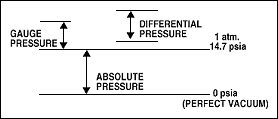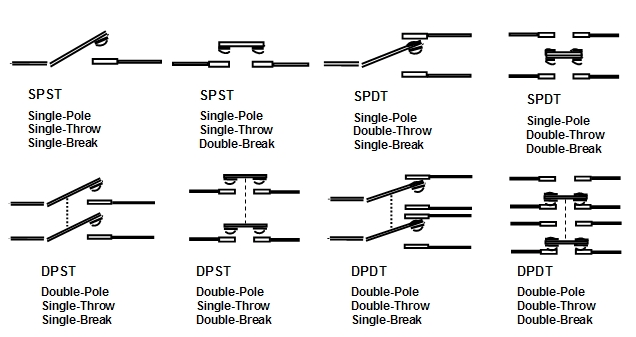Pressure Switches Information
Pressure switches are actuated by a change in the pressure of a liquid or gas. They activate electromechanical or solid- state switches upon reaching a specific pressure level to open or close a system.
Pressure Switch Measurement
Choices for pressure switch measurement ranges include:

Pressure reference. Image Credit: sensorsmag
Differential pressure switches give the relative pressure between two points. If both operating pressures are the same, the measuring element cannot move and no pressure will be indicated. A differential pressure is indicated when one pressure is higher or lower. Low differential pressures can be measured directly in cases of high static pressures. Sealed gauge pressure measurement is similar in concept to an absolute pressure switch, except that the pressure of the media to be measured is compared to standard atmospheric pressure (at sea-level).
Absolute switches are used where pressures are to be measured independently of the natural fluctuations in atmospheric pressure. The pressure of the media to be measured is compared against a reference pressure of absolute zero (absolute vacuum) in a sealed reference chamber.
Gauge switchesare the most common type of pressure switch. The pressure is measured relative to ambient pressure which is the atmospheric pressure at a given location. The average atmospheric pressure at sea level is 1013.25 mbar but changes in weather and altitude directly influence the output of the pressure sensor and switch. In this device, the input pressure is through the high port and the ambient pressure is applied through the open low port.
- Vacuum switches are used to measure the pressure lower than the localized atmospheric pressure. A vacuum is a volume of space that is essentially empty of matter. Vacuum switches are divided into different ranges of low, high and ultra-high vacuum.
- Sealed gauged switches react to pressure changes relative to one atmosphere at sea level (14.7 PSI) regardless of local atmospheric pressure.
Number of Poles and Throws
Most switches have one or two poles and one or two throws, but some manufacturers will produce custom level switches for special applications. The number of poles describes the number of separate circuits which can pass through the switch at the same time. The number of throws describes the number of circuits each pole can control. This is noted by the configuration of the circuit (NO/NC). Breaks are interruptions in the circuit caused by the separated contacts the switch introduces into each circuit it opens.
Single Pole, Single Throw (SPST) - Single pole, single throw (SPST) switches make or break the connection of a single conductor in a single branch circuit. They usually have two terminals and are referred to as single-pole switches
Single Pole, Double Throw (SPDT) - Single pole, double throw (SPDT) switches make or break the connection of a single conductor with either one of the two other single conductors. They usually have three terminals and are commonly used in pairs. SPDT switches are sometimes called three-way switches.
Double Pole, Single Throw (DPST) - Double pole, single throw (DPST) switches make or break the connection of two circuit conductors in a single-branch circuit. They typically have six terminals and are available in both momentary and maintained contact versions.
Double Pole, Double Throw (DPDT) - Double pole, double throw (DPDT) switches make or break the connection of two conductors to two separate circuits. They typically have six terminals and are available in both momentary and maintained contact versions.
Other- Other, special throw types with more than two poles. Examples include switches that are designed to split loads into separate circuits (e.g. headlamp switches).

Pole/throw configurations. Image Credit: Digi-Key
Sensor Technologies
Pressure switches may use various pressure sensing technology to create the switching action. Pressure switches may be completely mechanical and use technology such as piston or mechanical deflection. They may also use semiconductor or other electrical sensor technology that, in combination with additional electronics, provides a switching output. Sensor technologies for pressure switches include piston, diaphragm, strain gauge, semiconductor piezoresistive, piezoelectric, MEMs, variable capacitance, and vibrating element.
Pressure Switch Parameters
Other important parameters to consider include switch accuracy, the type of material to be measured, features such as temperature compensation and temperature output, and electrical output. Important operating parameters to consider include operating temperature, maximum shock, and maximum vibration. For more information on the parameters and features associated with pressure switches, read How to Select Pressure Sensors and How to Select Pressure Gauges.
Image credit:
Allen-Bradley/Rockwell Automation
- Alabama
- Arizona
- California
- Colorado
- Connecticut
- Florida
- Georgia
- Hawaii
- Iowa
- Illinois
- Indiana
- Kansas
- Kentucky
- Louisiana
- Massachusetts
- Maryland
- Michigan
- Minnesota
- Missouri
- North Carolina
- Nebraska
- New Hampshire
- New Jersey
- Nevada
- New York
- Ohio
- Oklahoma
- Oregon
- Pennsylvania
- Rhode Island
- South Carolina
- Tennessee
- Texas
- Utah
- Virginia
- Washington
- Wisconsin
- West Virginia
- Absolute
- Alarm Indicator
- Analog Current
- Analog Meter
- Analog Voltage
- Compound
- Differential
- Digital
- Double Pole
- Double Throw
- Electro-mechanical
- Gas
- Gauge
- Hazardous
- Liquid
- MEMS
- Mechanical Deflection
- Negative Pressure Output
- Normally Closed
- Normally Open
- Piston
- Sealed
- Semiconductor Piezoresistive
- Single Pole
- Single Throw
- Solid-state
- Special Digital (TTL)
- Strain Gauge
- Switch / Alarm
- TTL Compatible Switch
- Temperature Compensation
- Thin Film
- Vacuum
- bar
- psi
- brake pressure switch
- airtrol pressure switch
- differential pressure switch
- water pressure switch
- furnas pressure switch
- dual pressure switch
- adjustable oil pressure switch
- pressure switch telemecanique
- micro pressure switch
- furnace pressure switch
- 12v pressure switches
- pressure switch vogel
- georgin pressure switch
- miniature pressure switches
- pressure switch penn
- absolute pressure sensor
- analog pressure switches
- balanced magnetic switches
- condec pressure transducer
- DPDT pressure switches
- high pressure switches
- latching pressure switch
- micro gage transducer
- micro piston
- oxygen pressure booster
- pressure sensitive switches
- pro control pressure switch
- vapor pressure switch
- zadra pressure stripping
- photodiode temperature compensation
